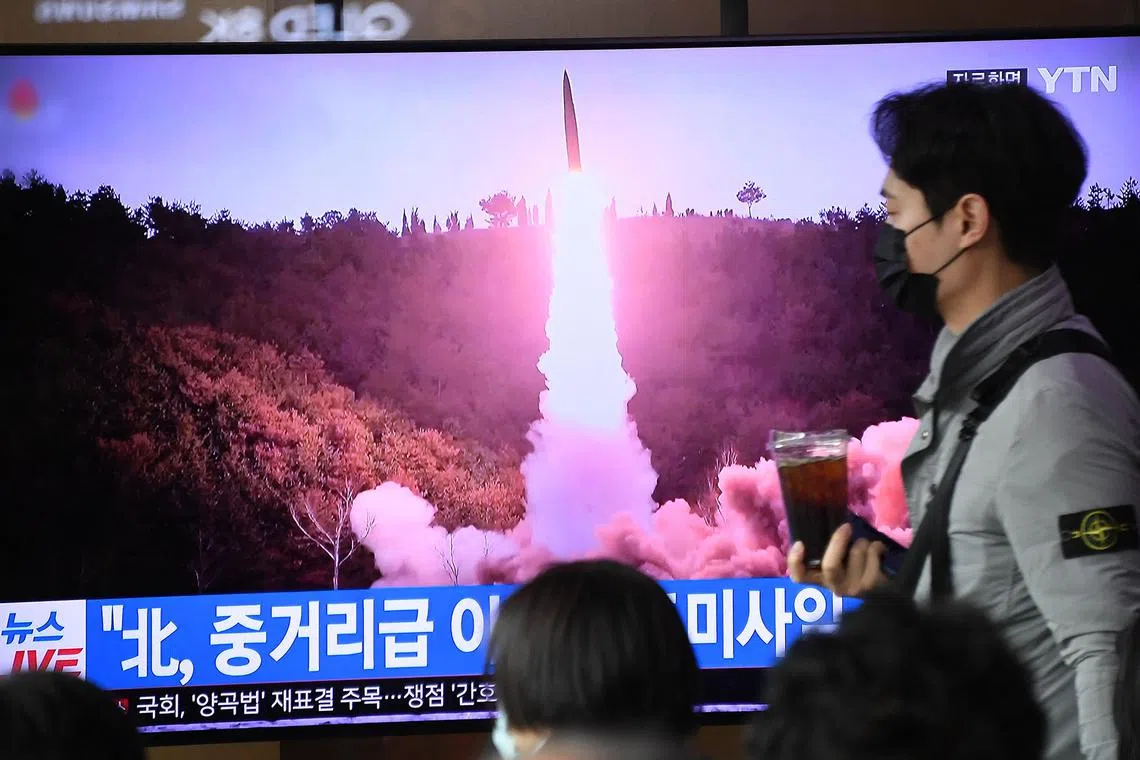North Korea says it has tested new solid-fuel ICBM, warns of ‘extreme horror’
Sign up now: Get insights on Asia's fast-moving developments

Developing a solid-fuel intercontinental ballistic missile has long been seen as a key goal for North Korea, as it could help the country deploy its missiles faster in the event of a war.
PHOTO: AFP
Follow topic:
SEOUL – North Korea said on Friday that it has tested the Hwasong-18, a new solid-fuel intercontinental ballistic missile (ICBM), aiming to “radically promote” its nuclear counterattack capability, state media reported.
North Korean leader Kim Jong Un guided the test, and warned the country will make enemies “experience a clearer security crisis, and constantly strike extreme uneasiness and horror into them by taking fatal and offensive counter-actions until they abandon their senseless thinking and reckless acts”.
North Korea has criticised recent United States-South Korea joint military exercises
South Korea’s defence ministry said North Korea was still developing the weapon, and that it needed more time and effort to master the technology, indicating that Pyongyang might carry out more tests.
North Korean state media outlet KCNA released photos of Mr Kim watching the launch, accompanied by his wife, sister and daughter, and the missile covered in camouflage nets on a mobile launcher.
A state media video showed the missile blasting off from a launch tube, creating a cloud of smoke.
KCNA said: “The development of the new-type ICBM Hwasongpho-18 will extensively reform the strategic deterrence components of the DPRK (Democratic People’s Republic of Korea), radically promote the effectiveness of its nuclear counterattack posture and bring about a change in the practicality of its offensive military strategy.”
“Pho” means “artillery” in Korean.
Analysts said the test would mark the North’s first use of solid propellants in an intermediate-range or intercontinental ballistic missile.
Developing a solid-fuel ICBM has long been seen as a key goal for North Korea, as it could help the country deploy its missiles faster in the event of a war.
More tests?
Most of the country’s largest ballistic missiles use liquid fuel, which requires them to be loaded with propellant at their launch site – a time-consuming and dangerous process.
“For any country that operates large-scale, missile-based nuclear forces, solid-propellant missiles are (an) incredibly desirable capability because they don’t need to be fuelled immediately prior to use,” said Mr Ankit Panda, a senior fellow at the US-based Carnegie Endowment for International Peace.
“These capabilities are much more responsive in a time of crisis.”
North Korea will most likely keep some liquid-fuel systems, complicating the calculations of the US and its allies during a conflict, Mr Panda added.
Mr Vann Van Diepen, a former US government weapons expert who now works with the 38 North project, said solid-fuel missiles are easier and safer to operate, and require less logistical support – making them harder to detect than liquids.
North Korea first displayed what could be a new solid-fuel ICBM during a military parade in February, after testing a high-thrust solid-fuel engine in December 2022.
Analysts said the US would be able to determine between a solid- or liquid-fuelled launch via early warning satellites that can detect differences in the infrared data produced by various missile types.
The latest launch came days after Mr Kim called for strengthening war deterrence in a “more practical and offensive” manner to counter what North Korea called moves of aggression by the US.
The missile, fired from near Pyongyang, flew about 1,000km before landing in waters east of North Korea, officials said.
A South Korean military official said the missile’s maximum altitude was lower than 6,000km, the apogee of some of last year’s record-breaking tests.
“North Korea could have opted to focus on collecting data necessary to check its features at different stages than going full speed at the first launch,” said Professor Kim Dong-yup from the University of North Korean Studies.
“As it was a test that did not demonstrate its normal flight pattern, North Korea will likely conduct some more tests.” REUTERS

